Silicon Valley Super Bowl: 10 Technologies Driving The Big Game
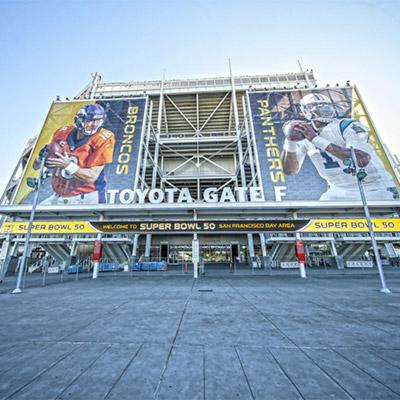
The Techiest Super Bowl Ever
This will be the most technologically advanced Super Bowl ever. And ground zero is Levi's Stadium in Santa Clara, Calif. The $1.3-billion home of the San Francisco 49ers is smack dab in Silicon Valley's backyard.
Come Super Bowl Sunday, Levi's Stadium will be one of the most wired places on the planet (at least for the day) with dozens of tech companies enabling the big game between the Denver Broncos and the Carolina Panthers. For starters, CBS will broadcast 5-K ultra-high-definition video to more than 114 million viewers, and companies such as Intel will power the game's nerve center from deep inside the venue's recesses, far from the roaring crowds.
It's no wonder Niners fans are affectionately called "Ninerds." Host sponsors for the stadium, which opened in 2014, include Apple, Google, Yahoo and Intel. But they’re not the only tech companies that will have a presence at the game. So will such goliaths as AT&T, and crucial niche firms such as Durham, N.C.-based SMT, which will be on the sidelines merging big data stats with cutting-edge graphics for TV viewers.
The following are 10 technologies that will have a presence on the field and around the stadium.

Aruba Networks: Helps Fans Find Their Way At Game
More than 75,000 tailgating Super Bowl fans will need all the help they can get come game time at Levi's Stadium. A nifty feature on the official Super Bowl 50 App for Android and iOS devices will help fans navigate their way to their seats, concessions and restrooms. The app is based on the stadium's longstanding Levi's Stadium App.
Aruba Networks, a Hewlett Packard Enterprise company, is the brains behind a clever feature that helps give attendees wandering the stadium turn-by-turn directions to help them get to where they want to go.
The technology behind this feature was created by Aruba, which deployed 2,000 Bluetooth Low Energy 4.0 beacons throughout the stadium. The beacons piggyback on the stadium's Wi-Fi gear and allow fans to not only know where they are, but also to order drinks and have them delivered. The beacons also allow concessions to easily locate the one out of 75,000 fans who placed a particular order for beer and nachos.
The beacons don't just help fans get beer faster, the technology can push out messages during the game to attendees such as "Lines for food and drinks are shorter just 30 feet ahead" and "Be in your seat in 15 minutes or you'll miss the pregame show."
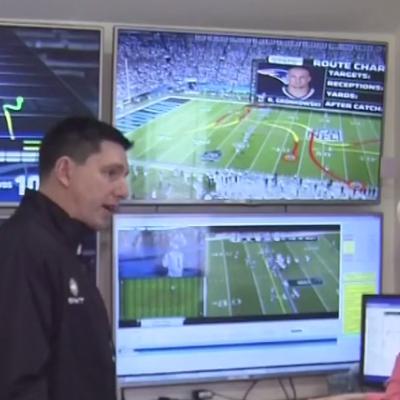
Zebra And SMT Deliver Next-Gen Sports Stats
Those watching the game from home don’t need to just rely only on that yellow first-down line superimposed over the football field. SMT, the sports technology firm based in Durham, N.C., will be sitting along the sidelines to make sure there are no hiccups when it comes to pushing out the on-field graphics overlaid for TV viewers to see along with adding some new wiz-bang graphics.
For this game, the company is upping its football game with technology that allows it to track every player's moves for real-time analysis by on-air sportscasters. SMT says each player will wear one of its chips, allowing the company to monitor where each one goes and how fast he moves, and to predict what the odds of success were on any given play.
Zebra Technologies will power the real-time player tracking of both Broncos and Panthers. The Lincolnshire, Ill.-based firm captures the high-speed player data and converts it to real-time, usable statistics. SMT also uses that data to create more precise graphics of previous plays.
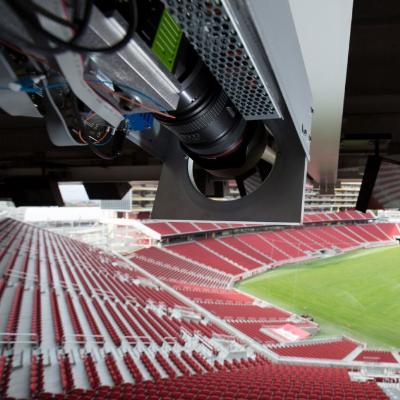
New Camera Technology Gives 'Matrix'-Like View
CBS is introducing new camera technology that will allow viewers to see "Matrix"-like playback views of any play from any player's perspective.
Thirty-six cameras on the top deck of Levi's Stadium will offer what is called Eye Vision 360. The cameras will allow CBS to freeze on any moment in the game and revolve around the play to give viewers a first-person perspective of any player on the field – "Matrix"-style. Each of the 5K resolution cameras will allow producers to "freeze" the action, zoom in to a player and wrap around the scene to give viewers a better taste of what players are up against when they're battling for a first down.
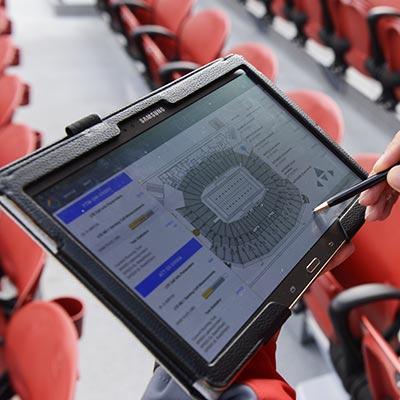
Verizon's Super Bowl Control Center
Verizon is setting up a temporary command center during the big game to monitor its cellular voice and data services and help identify and correct latency issues or capacity traffic jams. The Verizon Super Bowl command room will analyze traffic from the 49ers' stadium and include pop-up fan zones 40 minutes to the north in downtown San Francisco.
Verizon says it anticipates over a million extra smartphone users talking, tweeting and sending selfies in the Bay Area during Super Bowl week. Many of those taxing the cellular network will be Verizon customers.
The communications firm has deployed 100 engineers to monitor network traffic in real-time feeds that alert monitors to the number of active phones in Verizon's network. Next, if it detects a problem, Verizon says it can adjust bandwidth on the edge of the coverage map to support capacity.
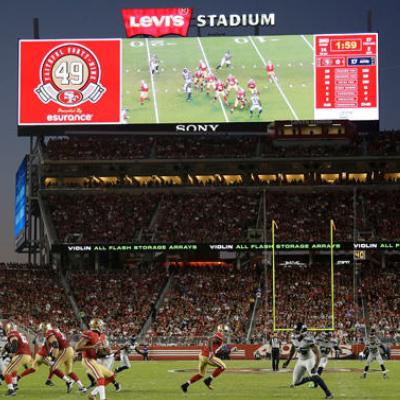
Sony's Huge Presence
Along with the estimated 100 million TVs tuned in to the Super Bowl, there will be 2,000 Sony TVs at Levi's Stadium on game day. That includes the massive jumbo screens all the way down to the 4K TVs inside the 170 luxury suites.
Sony's largest -- 48-foot by 200-foot -- LED screens are on either side of the stadium and feature, according to Sony, resolution of 4,648 by 1,120. For those doing the math, that's a mind-numbing 5.2 million pixels per display for a cost of $15 million per screen.
40 Gigabits Of Super Bowl Bandwidth
On Super Bowl Sunday, Levi’s Stadium might just become the biggest 3G, 4G, LTE and Wi-Fi network hot spot on the planet, supporting more than 75,000 fans, employees, concessionaires and reporters and their bandwidth-hungry devices. Helping the masses avoid bandwidth bottlenecks is Comcast, which has wired the place with 70 miles of 10-gigabit Ethernet networking cabling dedicated to 1,200 WiFi routers placed in every 100 seats throughout the stadium. Thanks to tech partnerships including Aruba Networks and Brocade, the backbone will deliver capacity of 40 gigabit-per-second bandwidth.
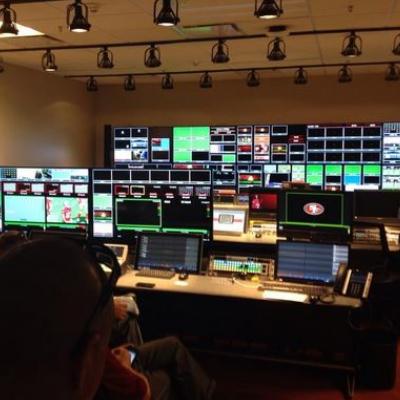
Carriers Spend Millions To Boost LTE Data Services
As for LTE data services, Verizon and AT&T say they have invested millions to help fans stay connected to social networks and consumer video content in and around the stadium.
As previously mentioned, Verizon is setting up a temporary war room to complement what it says will be $70 million in long-term LTE investments. Verizon says it will triple its LTE wireless data network capacity in and around Levi's Stadium along with other key spots in the Bay Area. AT&T says it has spent $25 million to boost its own LTE service by 150 percent over last year’s 49ers' home opening, making it available around the stadium and in Super Bowl party hot spots around San Francisco.
Levi's Stadium Super Bowl App: So Much More
The Super Bowl 50 stadium app was designed by the 49ers' in-house app development company VenueNext. Along with being able to direct you to your seat, the app also offers instant game replays from multiple camera angles, a celebrity Super Bowl "cam’ along with the ability to watch all those Super Bowl commercials that TV audiences get to see. As mentioned before, the app supports in-seat delivery of drinks (average regular season delivery time: 12 minutes) along with the ability to order food that can be picked up at "Express Pickup" windows.
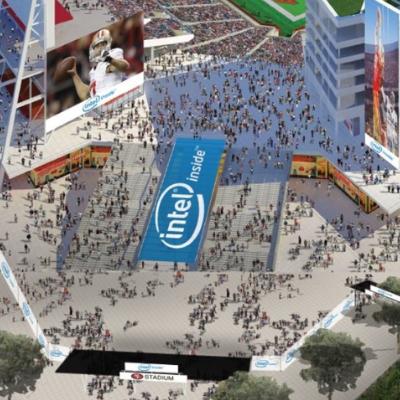
Super Bowl 50: Intel Inside
Below the throngs of Super Bowl fans will be an Intel data center inside the stadium. Intel, whose headquarters is just a few miles down the road from Levi's Stadium, maintains a data center with hundreds of rack-mounted Intel-based servers connected to miles of high-speed fiber-optic cable. According to Levi's Stadium, Intel's data center facilitates Internet traffic in and out of the stadium to the broader Internet. If needed, Intel says, it can tap remote data centers for remote compute power on demand.

A 'Grid-Neutral' Gridiron
On the environmental front, Levi's Stadium is using state-of-the-art environmentally friendly "green roof" technology that allows it to earn a Leadership in Energy and Environmental Design gold rating from the U.S. Green Building Council.
More than 20,000 square feet of solar panels pump out 500,000 kilowatt hours of energy, allowing the venue to power every San Francisco 49ers home game along with the Super Bowl.
On top of Levi's Stadium is a "green roof" with 27,000 square feet of space with a mix of native pants and solar panels. The stadium itself uses 80 percent recycled water.